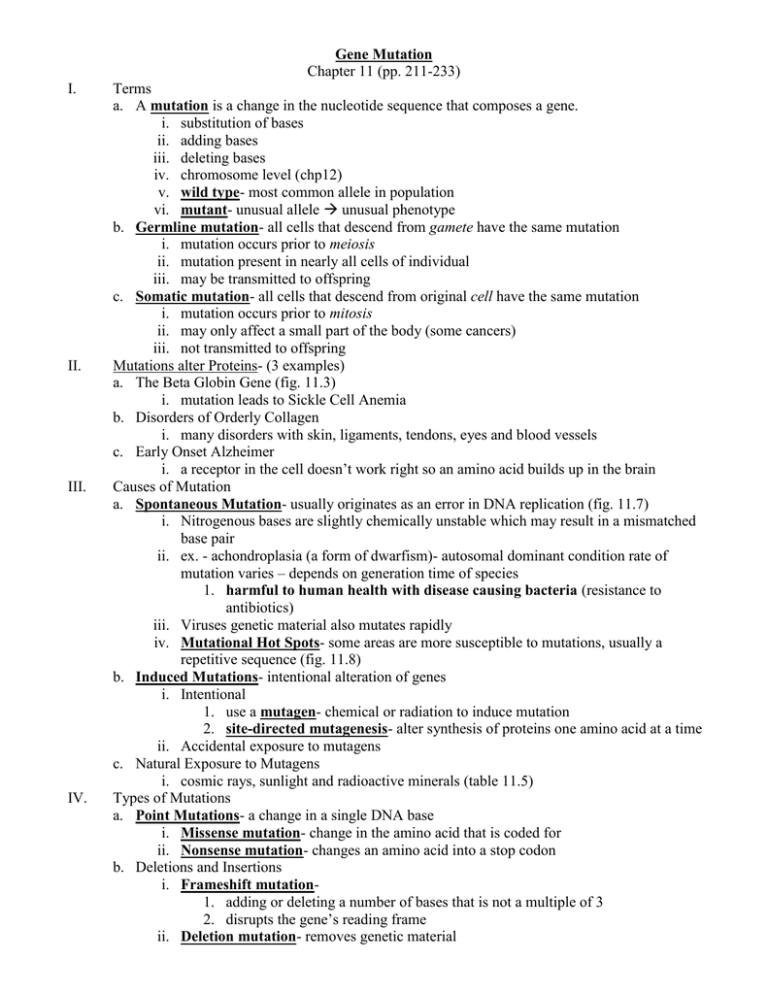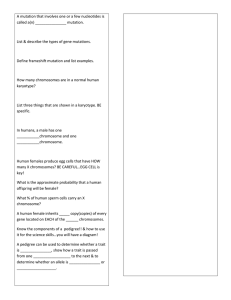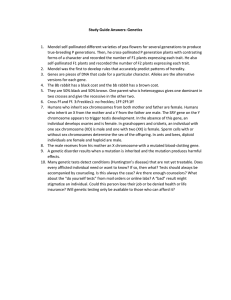Gene Mutation Chapter 11 (pp. 211-233) I. Terms
advertisement

Gene Mutation Chapter 11 (pp. 211-233) I. II. III. IV. Terms a. A mutation is a change in the nucleotide sequence that composes a gene. i. substitution of bases ii. adding bases iii. deleting bases iv. chromosome level (chp12) v. wild type- most common allele in population vi. mutant- unusual allele unusual phenotype b. Germline mutation- all cells that descend from gamete have the same mutation i. mutation occurs prior to meiosis ii. mutation present in nearly all cells of individual iii. may be transmitted to offspring c. Somatic mutation- all cells that descend from original cell have the same mutation i. mutation occurs prior to mitosis ii. may only affect a small part of the body (some cancers) iii. not transmitted to offspring Mutations alter Proteins- (3 examples) a. The Beta Globin Gene (fig. 11.3) i. mutation leads to Sickle Cell Anemia b. Disorders of Orderly Collagen i. many disorders with skin, ligaments, tendons, eyes and blood vessels c. Early Onset Alzheimer i. a receptor in the cell doesn’t work right so an amino acid builds up in the brain Causes of Mutation a. Spontaneous Mutation- usually originates as an error in DNA replication (fig. 11.7) i. Nitrogenous bases are slightly chemically unstable which may result in a mismatched base pair ii. ex. - achondroplasia (a form of dwarfism)- autosomal dominant condition rate of mutation varies – depends on generation time of species 1. harmful to human health with disease causing bacteria (resistance to antibiotics) iii. Viruses genetic material also mutates rapidly iv. Mutational Hot Spots- some areas are more susceptible to mutations, usually a repetitive sequence (fig. 11.8) b. Induced Mutations- intentional alteration of genes i. Intentional 1. use a mutagen- chemical or radiation to induce mutation 2. site-directed mutagenesis- alter synthesis of proteins one amino acid at a time ii. Accidental exposure to mutagens c. Natural Exposure to Mutagens i. cosmic rays, sunlight and radioactive minerals (table 11.5) Types of Mutations a. Point Mutations- a change in a single DNA base i. Missense mutation- change in the amino acid that is coded for ii. Nonsense mutation- changes an amino acid into a stop codon b. Deletions and Insertions i. Frameshift mutation1. adding or deleting a number of bases that is not a multiple of 3 2. disrupts the gene’s reading frame ii. Deletion mutation- removes genetic material V. iii. Insertion mutation- adds genetic material 1. tandem duplication- two copies of a gene next to each other c. Pseudogenes- not a coding gene but resembles a coding gene, can interfere d. Transposons- “jumping genes” a gene or DNA segment that moves to another chromosome e. Expanding Repeats- a gene grows with each generation leading to a worsened condition at a younger age f. Table 11.6 DNA Repair a. Excision repair- pieces are cut and errors are repaired (fig. 11.3) b. Mismatch repair- proofread DNA for misalignment of short repeated segments (fig. 11.14) Chromosomes Chapter 12 (pp. 235-262) Cytogenetics- a subdiscipline within genetics that links chromosome variations to specific traits I. II. III. What does a chromosome look like? (DNA Structure PowerPoint) a. heterochromatin- dark areas with mostly repetitive sequences b. euchromatin- lighter areas with more protein-encoding genes c. Telomeres- chromosome tips that shrink with each mitotic division d. Centromeres- the largest constriction of a chromosome where spindle fibers attach i. Composed of repeats of based sequences called an alpha satellite ii. Centromere-associated proteins iii. Kinetochore- part that actually hooks to the spindle fibers e. Subtelomeres- areas between the telomeres and the centromere before the protein encoding f. Karyotype- Chromosome chart (fig. 12.6 & 12.1) i. presents chromosomes by size and physical landmarks ii. during metaphase when chromosomes are coiled very tightly iii. discover translocations- transfer of material between nonhomologous chromosomes g. Chromosome shapes i. metacentric- centromere divides chromosome into 2 arms of approximately equal length ii. submetacentric- centromere makes one long arm and one short arm iii. acrocentric- the centromere pinches off only a small amount at end iv. telocentric- only one arm (none in humans) h. Long arm q and short arm p (petite) i. Ideogram- graphical representation of a karyotype (Fig. 12.10) Abnormal Chromosome Number a. Polyploidy-one or more extra sets of chromosomes (fig. 12.11) i. usually caused by oocyte fertilized by more than one sperm b. Aneuploidy- missing a single chromosome or having an extra one i. Trisomy-extra chromosome 1. Trisomy 21 ii. Monosomy- missing a chromosome (often lethal) 1. Turner Syndrome iii. Caused by nondisjunction- chromosome pair fails to separate at anaphase 1 or 2 iv. (fig. 12.12) c. Euploid- normal set Uniparental Disomy- Two genetic contributions from one parent








